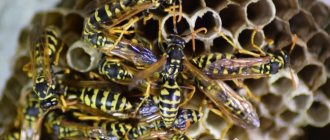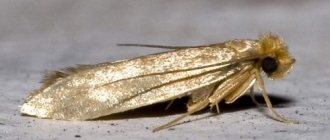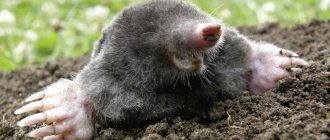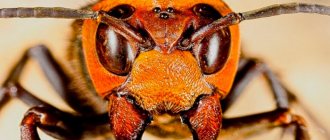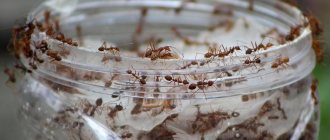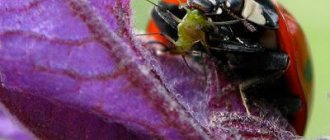A moth is an insect belonging to a species characterized by a wealth of species diversity. They are distinguished by the fact that they lead an active life mainly at night or at dusk. These insects differ from daytime insects in structure, having a longer body, and coloring - which is not as bright and colorful as those of sunlight lovers.
Appearance and structure of butterflies
Moths are called moths with different antennae, which is associated with the anatomical structure of the antennae, which look like feathers or threads.
What does a moth look like? Its body, like that of other species of this order of insects, has three sections, abdomen, sternum and head . The latter of butterflies does not differ in size; it is decorated with eyes and large antennae. There are 2 pairs of wings on the insect's chest, and its body is covered with tiny scales and hairs.
The oral apparatus has some features:
- the proboscis, with the help of which the insect takes food, is presented in the form of a flat spiral that folds and unfolds and opens directly into the larynx;
- when the proboscis is not required, it is twisted and hidden under the scales covering the butterfly's head;
- when expanded, the proboscis is ideally suited for absorbing liquids;
- adult individuals have jaws (similar ones can be seen in caterpillars and other types of insects), allowing them to chew through the necessary objects.
As for the wings, they practically do not differ from those found on daytime individuals. Night beauties have 2 pairs of wings, which are quite densely dotted with tiny hairs, as well as scales that form clusters of hairs.
The structure of the wings may differ among different subspecies:
- a butterfly may not have wings at all (this structure is passed on by insects from generation to generation and is an evolutionary manifestation);
- have a wide wing surface;
- have very narrow wings, almost linear.
The flight that a butterfly can demonstrate depends on the structure of its wings. For example, male mothfish are excellent flyers who dive superbly in the night sky. And their females can be either with or without wings.
On the other hand, there are known species of moths that have wings of a standard size and shape that do not allow the insect to fly (for example, the silkworm). The best developed flying apparatus is in the nocturnal moth - the hawkmoth subspecies, whose narrow wings have a high flapping frequency, allowing them to fly quickly and hover in the air for a while, as hummingbirds do.
Some subspecies of moths (the same hawk moth, glass moth) have no scales or hairs at all on the surface of their wings. However, this fact does not in any way affect their ability to fly; the narrowness of the wings allows them to stay stably in the air.
Small individuals have rather narrow wings, which keep them in the air only due to the thick scales located on the sides.
The main difference between diurnal and nocturnal butterfly species is the mechanism for attaching the rear and front pairs of wings:
- Bridle : in this case, a small process extends from the hind wings, which is inserted into a segment of the front wing. In males it is located on the lower part of the forewing, in females it is at the base of the medial vein; it is a cluster of villi.
- Jugum : on the forewing there is a small blade, which is fixed at its base. It is she who fastens both wings to each other.
The hawk moth is also active at night
The most beautiful moths
In our latitudes, moths are inconspicuous; they do not have an attractive color, but rather a protective one. A small black moth will not attract attention, but there are other species.
- Venezuelan Poodle. It was first described quite recently, in 2009, but it has not yet been possible to classify it. A distinctive feature is the hairiness of the butterfly; its hairs are longer and thicker than those of other representatives of Lepidoptera.
- Saturnian moon. This species is considered one of the largest moths, the wingspan of an adult is up to 12 cm. It lives in the forests of North America, preferring the east coast of the mainland.
- Peacock eyes. This species is recognized as one of the most beautiful and largest; the wingspan of the butterfly can reach 25 cm. The colors are variegated.
- Saturnia cecropia. The caterpillars feed exclusively on maple leaves, and the insect itself is nocturnal. It differs from all others in its large size; its wingspan opens to 12 cm.
- Fingerwing. The strange shape of the body allowed this moth to get into the rating. The body structure resembles the letter T, the wings are thin, and the butterfly itself looks fragile. The caterpillar of this species eats carnivorous sundews.
- Royal walnut moth. Its homeland is the south of North America, the wingspan is not very large, only 10 cm, but the fatness of the insect allows it to be considered one of the largest in the world. It is also called the red moth because of the specific color of its wings.
The sense organs of butterflies are presented as follows:
- Olfactory organs : in a moth they are outgrowths shaped like a cone or a wedge. Around them there are a number of sensory cells that lie in the deep layers of the skin and connect to the nerves responsible for sensory functions. Butterflies' sense of smell is quite acute, and it is thanks to it that they find males, females or food.
- Hearing organs : some individuals are distinguished by the presence of tympanic organs, which are absent in diurnal moths. Receptors of this type are located on the abdomen or back of the sternum, in special lateral recesses, which are covered with a cuticular membrane (underneath there is a trachea). Sound waves that travel through the air cause the membrane to vibrate, causing cells to be excited and information to be transmitted through sensors.
- Organs of vision : moths have two faceted eyes that occupy the main surface of the head. These organs of vision have the same structure as those of other insects: they consist of many small elements, including the lens, retina and innervation. As a rule, moths see much better up close than at a distance. The organs of vision of moths are designed, first of all, to detect oncoming movement and move in space themselves.
The eyes of butterflies are designed in such a way that they perceive all information separately. Therefore, the insect receives a mosaic image as output, which enlarges the real image of the object several times.
Eye structure
Features of color
Having seen the flourishing of these insects, many wonder whether moths are dangerous. In fact, they are no more dangerous than the daytime varieties, but the pigmentation of the moths deserves attention.
The color of butterfly wings has a dual nature: structural and pigment . This means that the scales that are located on the surface of the insects’ body contain pigment. It is this substance that absorbs the sun's rays or simply daylight and reflects them, due to which the solar spectrum of shades visible to the human eye appears. As for the structural part of the color, it appears as a result of the refraction of the sun's rays, which does not require the presence of pigment.
Important! Moths have predominantly pigmented coloration.
Ways to protect yourself from enemies
The moths of Russia, and all others, are created by nature in such a way as to have protection from ill-wishers.
A list of defense mechanisms of moths is presented below.
Construction of shelters : different subspecies of moths organize similar protective structures for themselves. For example, caseworms and bagworms. The caterpillars of these moths, some time after hatching, build houses around which they attach pieces of foliage and various debris.
These shelters are designed in a special way so that the larva protrudes from them just enough so that in case of danger it can quickly hide inside . The house grows with its owner, at least until she grows up and becomes a pupa (this size is approximately 4-5 cm). After the allotted time, the butterflies come out, but only if we are talking about males. The females stay in these houses longer, until they are fertilized by the male and lay eggs.
Defensive body structures , including hairs and glands, are also defense mechanisms for moths. Do moths bite, having such a formidable weapon? The answer is obvious: only if necessary.
Many caterpillars have a series of bristles or hairs that can burn with poison hidden in the skin glands. During an attack, a dangerous mixture is sprayed from the tip of the bristles, which irritates the skin of the enemy.
In addition, insects use the following means of protection:
- glands in the larvae, with the help of which they cover their own bodies with a liquid that repels approaching predators;
- individual individuals begin to actively move when the enemy approaches, or pretend to be dead, or curl up into a tight ball;
- the larvae, at the moment of approaching danger, can fall from the branches on which they live, hanging on thin silk threads (the individual returns back along the same thread, slowly moving along it with its legs located on the chest and oral appendages);
- hawk moths have dorsal growths that look like horns, which they point towards approaching danger;
- insects can defend themselves with the help of long, prickly hairs covering their body.
The pupae of moths, so helpless in appearance, also have mechanisms to protect themselves from a sudden enemy attack:
- pupae living in the soil are colored in colors that make them invisible;
- moths weave silk cocoons (in the silkworm, such shelters can have up to three layers - loose, dense and filmy), in which they hide from attacks by predators.
How to feed butterflies
The insects themselves cannot see and fly up to the treat. If the taste buds have not worked, then it is recommended to help them. Take a toothpick and slowly spin the proboscis with it, pointing it towards the food. There is no point in holding the butterfly. During feeding, you can see the proboscis moving more intensely. After the insect has eaten, it simply flies away.
We all love butterflies. Their beauty, variety of colors and patterns evoke surprise and admiration. However, we know practically nothing about these incredibly beautiful creatures, except that they do not live long, emerge from their pupae and herald the arrival of spring. Many people have no idea what the tiny creatures eat. What do butterflies eat?
With simple measures you can create accommodation for animals during the cold season. In autumn, nature prepares for the approaching winter. The plants are losing their leaves and the last fruits are ripening. Many animals go to their winter quarters. Some people quickly make camp for food, others are simply forced to survive the winter.
Food for the cold season
Many beneficiaries look for homes in the remains left behind by plants. They seek refuge in blades of grass or hide in tufts of rice. Earth beetles that love to eat snails.
- Raise a good pile of leaves as overwintering habitat for your hedgehog.
- Leave the dead plant stems over the winter and don't remove the beds until spring.
The bird feeder is an irresistible temptation for birds that do not fly south. But hedges whose berries have been preserved in winter are loved dearly. For example, in rosehip or hawthorn bushes between the prickly tendrils, they can also hide perfectly from cats.
Coloring to protect against predators
The protective pigmentation of moths has two types of colors:
- Patronizing (cryptic) - helps butterflies to merge with the surrounding space. For example, a moth can completely blend in with the needles on a spruce tree or the leaves on a tree. Other subspecies may have the appearance of tree knots, freezing on a branch at the moment of danger, pretending to be the smallest branches (this is what moths and ribbon moths do).
- Warning (repellent) - in itself attracts the attention of predators, but draws their attention to the fact that the individual has protective means in its arsenal (unpleasant taste, caustic secretion of the glands, the presence of burning hairs on the surface).
The ability of moths to camouflage themselves when danger approaches is admirable. Some blend in with granite rocks, others take on the appearance of bird droppings, and others take on the appearance of bark, flowers or foliage.
Ribbon flies are distinguished by their color, which is visible during flight on their outstretched hind wings. However, this species is completely invisible at rest, if the butterfly folds its wings, the pattern on its back resembles foliage or tree bark.
The wings of night beauties are often decorated with a pattern in the form of wide open eyes. This helps keep predators at a distance.
Eye pattern on wings
What happens in winter?
Some species of butterflies live only during the summer. Other lepidopterans wait out the cold in the pupa: the insect is alive, but is in a state of suspended animation. It is unlikely that it will be possible to awaken the insect; it will wake up from hibernation on its own when living conditions become normal. Adults hide from frost in trees, under the bark. Certain species fly to warmer climes like birds.
For the butterfly to go into suspended animation, the temperature must drop. At home, if the temperature is maintained at a warm temperature, the insect will not fall asleep.
Industrial melanism
Industrial melanism is the presence in the body of moths of a pigment that makes them darker than other individuals. This ability is inherited.
Currently, there is a tendency towards an increase in individuals of the melanized species, especially for populations living in Europe. If previously the light color of the night moth was the species norm, today dark moths are replacing them. Despite the fact that the survival rate in nature is higher in light-colored moths, dark ones are better adapted to life with nutritional deficiencies. However, constant clashes with predators leave melanists in the minority.
In areas with industrial production, where many objects of the plant world are covered with soot, melanistic butterflies survive better than their white counterparts, because their camouflage abilities are higher . In addition, they feed on food that is contaminated with industrial waste and this does not in any way affect their life activity, unlike light-colored moths.
Life cycle
How long do moths live? The life cycle of these insects deserves close study; it can be divided into several successive stages:
- Eggs are laid by these moths either in the form of heaps or individual specimens. Moreover, females are able to lay them directly during flight, place them on objects or in vegetation tissues.
- After the allotted time, caterpillars emerge from the eggs, having a head, three pairs of legs with marigolds on the chest, and five pairs of legs on the body. After surviving periods of molting, the caterpillars are enclosed in a cocoon called a pupa. In it, the individual cannot move; the paws are tightly pressed to the body.
- After a while, an adult moth emerges from the pupa.
How do butterflies become pests of the national economy?
The most destructive period for plants is the end of spring - the beginning of summer. It is at this time that the caterpillars, before pupating, gain strength by eating everything that comes their way. After several weeks, the butterflies hatch from their pupae. These insects do not live long and die en masse, but this does not make them smaller, since they manage to lay eggs.
Feeding point for butterflies from mason jar
What you need for the butterflies:.
- a small heater with a lid - scissors - a sponge or cotton cloth - sugar - water - perhaps felt or balsam wood in a teardrop shape. You need a piece of string. The length should be at least three times the length of the mason jar. Use this string to create macramé that you can use to hang a mason jar to immerse the butterflies later. A beautiful macrame pattern is created in principle thanks to the knots that are connected. For this reason, this is also the next step for the butterfly feed station. Start with a knot around the mason's neck. This should be bound so that the end of the string remains the same length.
Thus, beautiful butterflies are serious pests, and the nutrition of their offspring is connected with this.
What do butterflies eat?
Some time after the transformation from a pupa to a butterfly, it destroys all the protein in its reserves and goes in search of food.
All butterflies have a proboscis - long and mobile, which is formed from elongated and modified jaws; it is this that allows them to suck nectar from flowers or juice from crevices in trees and fruits. If the butterfly is ready to eat, its proboscis, which is always curled, unfolds, allowing it to feast on something or drink water.
As a rule, the proboscis of moths differ in their length . The latter depends on the depth of the flowers on which one or another individual usually feeds. For example, in tropical hawkmoths, the size of the proboscis can reach a quarter of a meter.
A butterfly that flies from flower to flower in search of food also pollinates plants. This occurs by transferring pollen on stalks from one specimen to another.
What do moths eat:
- fruit juice;
- juices of various plants;
- rotting fruits and vegetables;
- sweet substance secreted by aphids;
- bird excrement;
- flower nectar.
Methods of food absorption may vary among different subspecies of night beauties.
- Large swallowtails flutter their wings while drinking, hovering over the plant, and only slightly touch the petals with their limbs. Therefore, space is important for them, so that nothing interferes with the unfolded wings in movement.
- Hawkmoths also hover in space, like hummingbirds; they never land on a flower or touch the corolla.
- Other species traditionally sit on the flower and leisurely enjoy the sweet nectar. At the same time, their luxurious wings are folded.
They feed mainly on nectar from flowers
Hawkmoth hovers over a flower while eating
Amazing metamorphoses
Many people remember from school that the life of a butterfly is divided into four stages: egg, larva, caterpillar and moth. Moreover, this amazing creature consumes the largest amount of food in the form of a caterpillar. What do we know about this immature butterfly metamorphosis? What do young caterpillars eat?
To be honest, these creatures can eat almost all types of plant foods. For example, the same tree leaves, fruits or berries. In general, there are no restrictions, although each butterfly species has its own preferences. They depend on the habitat, as well as on the abundance of flora that reigns there.
Habitat
Moths are distributed almost everywhere; they cannot be found only in Antarctica. The ability of moths to fly is very developed, so they can be found both on the continent and on islands in the ocean.
Moths in central Russia are a fairly common phenomenon. They can be found even in the most abandoned places, traveling through the air on silk threads to which they are attached. In addition to this method of movement, caterpillars can move by attaching to broken branches of trees or whole logs that were moved from place to place after heavy rains or the flow of a river.
Some nocturnal moths live only in the habitats where they first appeared. For example, the yucca moth starts and lives only in yucca thickets.
The following moths are known in the Moscow region:
- fine strands;
- bagworms;
- wood borers;
- cocoon worms;
- birch silkworms;
- slugs;
- peacock eyes;
- corydalis;
- moths;
- nolides.
Why are they dangerous for humans?
Adults feed exclusively on flower nectar; large butterflies have the same diet. Night moths do not cause any harm to agricultural land or to humans personally. But the caterpillars eat herbaceous plants, which can have a detrimental effect on the quantity of the harvest and its quality. That is why butterflies of all sizes and colors are often disliked by farmers.
Butterfly
The imago cannot cause harm to humans, but some types of caterpillars secrete toxic substances that, if they come into contact with the skin, can cause allergic reactions of varying complexity.
You should never touch the caterpillar with unprotected hands.
Benefits and harms
One interesting sign is associated with moths: if a representative of this type of insect flies into a house, this promises its owners a lot of pleasant things, in the form of good luck and prosperity.
Moths, which have a mouthpart with a soft proboscis that cannot pierce tissues of plant and animal origin, do not cause any harm to humans. In addition, they bring a lot of benefits. They pollinate a variety of plant crops by feeding on pollen . For example, yucca can only be pollinated by yucca butterflies, whose ovules cannot be fertilized without an external pollinator. These butterflies fashion a ball of pollen, which is placed on the pistil of a plant.
The behavior of moths is quite complex, but it is precisely this that ensures the reproduction of certain types of crops.
However, these beautiful moths can not only bring benefits, but also some harm. The caterpillars of these individuals are quite voracious, due to which the following damage is caused:
- damage to foliage, roots and stems;
- eating food;
- damage to fibers and materials.
The larvae of night moths can greatly harm agriculture. For example, keratophagous moths lay their eggs on the fur and hair of domestic animals. Occasionally they use these raw materials to build their own cocoons.
Known harm is caused by:
- grain moth;
- Indian meal moth;
- barley moth;
- mill fire.
These insects are capable of destroying grain stored in warehouses. These types of butterflies are distributed throughout the world, which forces farmers to constantly use insecticides to protect their farms from extermination.
The caterpillars, a type of leaf miner or miner, feed on plant elements found in the central part of the foliage. In order to get to them, the caterpillars gnaw through long passages and cavities located under the epidermis. Other larvae are capable of making real miniature tunnels inside the root system, branches and trunks of trees. In such a secluded place they live for quite a long time, reliably hidden both from predators who encroach on them and from the person trying to exterminate them.
The most noticeable damage caused by moth caterpillars is the destruction of leaf cover. Hungry larvae sometimes become a real disaster; they are capable of completely denuding fields, removing foliage from plants in vegetable gardens, and even completely changing the appearance of green spaces.
Mineral salt diet for offspring
It is worth noting that salt and minerals are especially important for males during the mating period. Without these elements, the mating season may not produce offspring. However, butterflies are able to replenish their reserves without feces or human sweat. In their absence, they obtain salt and minerals from dirt, the most common, for example, from puddles.
Organic Gardening - Product Database
Food sources for nest boxes and habitats
Imagine a more complete garden!
Isn't this a great idea? But if you don't want to plant certain flowers for this purpose, which also requires more or less care, we have found the perfect alternative. Why only feed birds in winter using a birdhouse when you can do the same for butterflies in summer? At butterfly feeding grounds, you can watch these magical creatures and enjoy their grace. These nutrients are transferred from male to female during the process of copulation. They make the eggs laid stronger and transmit the necessary genetic information. And this is very important. That is why in warm weather, when puddles dry up, many male butterflies of various species accumulate around the puddles and replenish their reserves of salt and minerals.
Build your own butterfly feeding area
A butterfly feeding station also ensures that more butterfly species visit your garden. You'll be amazed at how many different species there are in your area that you didn't know about. If you now feel like equipping your garden with such a feeding station, you can either buy a ready-made one or make it yourself. In this article, we have a simple guide through which you can make the perfect feed from a few items that you have mostly even in your house.
Why do butterflies strive for light?
The question of why moths fly towards the light interests many. Moreover, not only nocturnal varieties of moths, but also daytime ones can fly towards the beckoning rays, often by mistake. Although such a reaction is more often due to the fact that such individuals simply fell asleep near the light source, and when darkness fell and it turned on, they became frightened and rushed to escape.
Artificial light has a huge negative impact on nocturnal insects; this trend is especially pronounced in megacities, where there are a lot of light sources. Every year, carried away by the alluring electricity, millions of moths die.
According to recent studies, moths are increasingly less likely to seek light. This is due to the formation of special behavioral mechanisms in them that help them avoid harmful effects. Researchers used ermine moth caterpillars. These insects were raised until the first molt, half in suburban areas with a minimum of artificial lighting, the other half in areas where street lighting was maximum. As the results of the study showed, those butterflies that emerged from caterpillars that grew in places with bright lighting were 30% less likely to rush into the light than those that grew in areas with a minimum of light.
Blind Hawkmoth
What do butterflies eat at home?
One of my friends has pet butterflies
.
To be honest, I don’t understand what motivates his hobby, but he really cares a lot about his pets and even prepares special nectar
.
It consists of water, honey, sugar and fruit. Butterflies need to be fed once a day.
As far as I know, domestic butterflies can also be given rotten fruits, liquid honey and just sweet water.
But even without coconut moths, caterpillars can still be found in the winter—if you study them carefully. Because they also come to a safe place. Popular hiding places are found throughout the plant kingdom, such as under the bark of a tree. Butterflies go even further in metamorphosis, in particular, by the way, the Apollo butterfly and the so-called kidney patch. Although they lay eggs in the summer, it will take until next spring for the hatches to be cleared. However, the cold season can be overcome quite comfortably.
Expats: Rest until the protective warmth!
However, butterflies do not always prefer their local winter habitat. These include, for example, migrating butterflies that instead seek the protective warmth of more southern climates. Among them, for example, is an admiral or a painted lady. Some of them even cross paths to reach Southern Europe or even where the butterflies find sufficient food sources in winter. As average temperatures rise as a result of climate change in this country, there are more and more of these butterflies in Germany during the winter.
Butterflies are interesting creatures to observe because there are still many aspects of their lives that no one has been able to explain.
Species of moths
Moths are traditionally divided into 2 subspecies:
- Palaeolepidoptera are represented by miner caterpillars and small forms.
- Neolepidoptera , this includes most butterflies.
Representatives of these subspecies differ from each other in various characteristics relating to the structure of the larvae, mouthparts, wings and genitals.
Night butterflies include:
- glass bees, slender, similar to bees with the thinnest scaleless wings;
- moths, small individuals with triangular wings, most often pests;
- fingerwings, distinguished by dissected wings with scaly fringe;
- true moths, tiny specimens with scales along the edges of their wings;
- notch-winged moth, which has a bright color and is a dangerous pest;
- hawk moths, a large species of butterfly similar to hummingbirds;
- bagworms, in the form of round dark females and males, devoid of wings;
- peacock eye, which has wide wings with a pattern in the form of eyes and a dense body;
- moths, very slender butterflies whose caterpillars crawl, bending in the form of a loop;
- leaf rollers, whose folded wings are shaped like a bell, and the individuals themselves are pests that eat buds and apples;
- cocoon moths, hairy beauties whose caterpillars cause a lot of damage to foliage;
- she-bears with brightly colored wings;
- scoop, inconspicuous butterflies whose wings are brown and antennae in the form of threads;
- moths, the females of which do not have wings, and the males sport gray wings with antennae.
Photos with names
Night peacock eye
Green moth
Peacock eye - large nocturnal peacock eye
